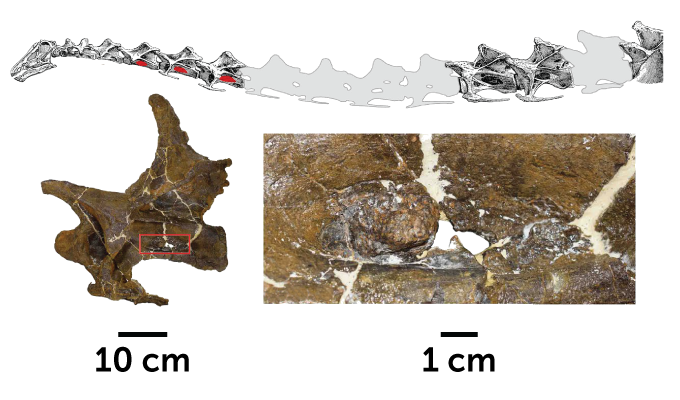The prehistoric world wasn’t a paradise free of disease, but diagnosing ancient ailments is tricky: Germs usually don’t fossilize well. Now, though, researchers have unearthed evidence of what appears to be the oldest known respiratory infection in a dinosaur.
Lesions found in the vertebrae of a 150-million-year-old juvenile sauropod dubbed “Dolly” point to a lung infection that moved into her bones, vertebrate paleontologist Cary Woodruff and colleagues report February 10 in Scientific Reports. That’s at least 50 million years older than the previously reported respiratory infection in a titanosaur unearthed in Brazil.
Dolly, a long-necked dinosaur, was probably closely related to Diplodocus. At the time of her death in what’s now southwestern Montana, she was about 18 meters long and less than 20 years old, Woodruff estimates.
The fossils that the team analyzed include the dinosaur’s skull and the first seven neck vertebrae, which contained air sacs connected to the lungs and other parts of the respiratory system. The bones of many of today’s birds, which are modern-day dinosaurs, have similar features.
On the fifth through seventh vertebrae, the fossils have bone lesions at spots where the air sacs would have intruded into the bone, the team found. The oddly shaped and textured bumps protrude from the bone as much as 1 centimeter, says Woodruff, of the Great Plains Dinosaur Museum in Malta, Mont.
 Bone lesions in the fifth through seventh neck vertebrae (location marked in red, top) of a dinosaur dubbed “Dolly” may have stemmed from a long-ago infection in air sacs in those vertebrae. The lesions show up as lumpy protrusions (seen at bottom right in a close-up of the spot highlighted in the red box on the vertebra at bottom left).D.C. Woodruff et al/Scientific Reports 2022Bone lesions in the fifth through seventh neck vertebrae (location marked in red, top) of a dinosaur dubbed “Dolly” may have stemmed from a long-ago infection in air sacs in those vertebrae. The lesions show up as lumpy protrusions (seen at bottom right in a close-up of the spot highlighted in the red box on the vertebra at bottom left).D.C. Woodruff et al/Scientific Reports 2022
Bone lesions in the fifth through seventh neck vertebrae (location marked in red, top) of a dinosaur dubbed “Dolly” may have stemmed from a long-ago infection in air sacs in those vertebrae. The lesions show up as lumpy protrusions (seen at bottom right in a close-up of the spot highlighted in the red box on the vertebra at bottom left).D.C. Woodruff et al/Scientific Reports 2022Bone lesions in the fifth through seventh neck vertebrae (location marked in red, top) of a dinosaur dubbed “Dolly” may have stemmed from a long-ago infection in air sacs in those vertebrae. The lesions show up as lumpy protrusions (seen at bottom right in a close-up of the spot highlighted in the red box on the vertebra at bottom left).D.C. Woodruff et al/Scientific Reports 2022
So many lesions turning up in similar spots are unlikely to be bone tumors, which in birds are rather uncommon anyway, Woodruff notes. Instead, the lesions formed in response to a respiratory infection that spread to the distant air sacs, the team proposes.
Though Dolly’s bone lesions wouldn’t have been obvious to an ancient observer, she likely had a fever, cough, labored breathing and nasal discharge, the scientists suggest.
It’s not clear whether the infection was bacterial, viral or fungal, or whether it is what killed Dolly. But the researchers note that many birds and reptiles today can suffer from a respiratory infection caused by the fungus Aspergillus that can in turn lead to bone infections.

Sign Up For the Latest from Science News
Headlines and summaries of the latest Science News articles, delivered to your inbox
Client key* E-mail Address* Go
Thank you for signing up!
There was a problem signing you up.
For an infection in the neck vertebrae’s air sacs to cause bony lesions, “you’re looking at a chronic condition,” says Cynthia Faux, a veterinarian at the University of Arizona in Tucson with a degree in vertebrate paleontology who was not involved in the study.
Diseases such as arthritis and gout as well as other infections have been reported previously in dinosaurs and other ancient creatures (SN: 12/11/01). And while Dolly’s respiratory infection seems to be the oldest known for a dinosaur, it’s nowhere near the record. In 2018, researchers described a tuberculosis-like infection in a marine reptile that lived about 245 million years ago.

